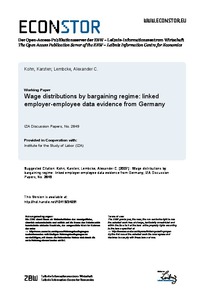Wage distributions by bargaining regime: linked employer-employee data evidence from Germany

Kohn, Karsten ; Lembcke, Alexander C.
Institute of Labor Economics, Bonn
IZA - Bonn
2007
28 p.
collective bargaining ; statistics ; wage determination ; wage structure
Discussion Paper Series
2849
Collective bargaining
English
Bibliogr.
"Using linked employer-employee data from the German Structure of Earnings Survey 2001, this paper provides a comprehensive picture of the wage structure in three wage-setting regimes prevalent in the German system of industrial relations. We analyze wage distributions for various labor market subgroups by means of kernel density estimation, variance decompositions, and individual and firm-level wage regressions. Unions' impact through collective and firm-level bargaining mainly works towards a higher wage level and reduced overall and residual wage dispersion. Yet observed effects are considerably heterogeneous across different labor market groups. There is no clear evidence for wage floors formed by collectively bargained low wage brackets which would operate as minimum wages for different groups of workers."
Digital
The ETUI is co-funded by the European Union. Views and opinions expressed are however those of the author(s) only and do not necessarily reflect those of the European Union or the ETUI.